|
With the advent of E-Cigarettes most people would be forgiven for thinking that the threat from secondary smoking was finally dealt with - But not so shows a news study from the University of Connecticut in the USA.
Furthermore, the study concludes: "Nicotine-based e-cigarettes are potentially as harmful as unfiltered cigarettes when it comes to causing DNA damage."
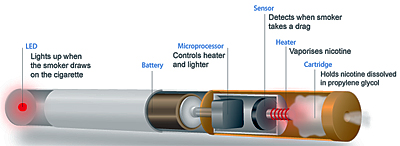 There are potentially hundreds of chemicals in e-cigarettes that could be contributing to DNA damage, and some of these have been found to be present in the vapour exhaled by the user, which puts the often claimed lie that it is purely water vapour well and truly in the basket of falsehoods being put out by the industry, along with that of their claim that nicotine itself is harmless and it is the smoke form the tobacco that causes health problems - an attitude which is dismissed as false by the science. There are potentially hundreds of chemicals in e-cigarettes that could be contributing to DNA damage, and some of these have been found to be present in the vapour exhaled by the user, which puts the often claimed lie that it is purely water vapour well and truly in the basket of falsehoods being put out by the industry, along with that of their claim that nicotine itself is harmless and it is the smoke form the tobacco that causes health problems - an attitude which is dismissed as false by the science.
In July of this year, an analysis published by the Journal of Analytical Toxicology, showed that the main e-liquid constituents were propylene glycol, glycerol, and nicotine. However, they also found multiple potentially harmful components (trace elements, polycyclic aromatic hydrocarbons (PAHs), pesticides and carbonyl compounds).
The researchers had completed a multicomponent analysis of six e-liquid refills and their resultant vapour emissions (generated by a smoking machine), and compared them with tobacco smoke.
As for Nicotine - it kills, and that is a fact irrespective of how it is delivered into the human body. Nicotine has three forms, of which "free-base" nicotine is the only one that gets absorbed by the body, making it the most addictive kind. A number of investigation into what kind of nicotine is in the liquids used in e-cigarettes, have shown that in some; this kind addictive nicotine is present.
There is no dubiety in the evidence that nicotine itself causes heart problems.
As reported by Science Daily, UConn's scientists decided to look into whether the chemicals in e-cigarettes could cause damage to human DNA while testing a new electro-optical screening device they developed in their lab. The small 3-D printed device is believed to be the first of its kind capable of quickly detecting DNA damage, or genotoxicity, in environmental samples in the field, the researchers say.
In this study, the researchers extracted samples from e-cigarettes and tobacco cigarettes using an artificial inhalation technique which uses a tube that contained a cotton plug. The researchers then used a syringe at the other end of the tube to replicate inhalation. Samples came from the chemicals captured in the cotton.
The team set their test so that 20 puffs of an e-cigarette was roughly equivalent to smoking one tobacco cigarette, a ratio supported by other research. The team gathered samples at 20, 60, and 100 puffs. The potential DNA damage from e-cigarettes increased with the number of puffs, Kadimisetty says.
"Some people use e-cigarettes heavily because they think there is no harm," he says. "We wanted to see exactly what might be happening to DNA, and we had the resources in our lab to do that."
Several studies have demonstrated formation of toxic aldehydes in e-cigarette vapours during their use.
E-cigarette e-liquids contain propylene glycol and glycerol, which due to thermal decomposition produces aldehydes (formaldehyde) and is given off in the vapour.
But flavouring compounds used in E-cigs has been mostly ignored.
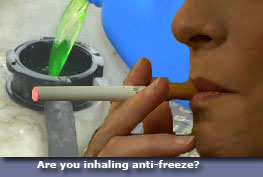 In a study paper by the Department of Atmospheric Sciences, Desert Research Institute, in Nevada USA, published in November 2016 stated that researchers measured several toxic aldehydes produced by three popular brands of e-cigarettes with flavoured and unflavoured e-liquids. In a study paper by the Department of Atmospheric Sciences, Desert Research Institute, in Nevada USA, published in November 2016 stated that researchers measured several toxic aldehydes produced by three popular brands of e-cigarettes with flavoured and unflavoured e-liquids.
The study showed that within the tested e-cigarette brands, thermal decomposition of flavouring compounds dominates formation of aldehydes during vaping, producing levels that exceed occupational safety standards.
Production of aldehydes was found to be exponentially dependent on concentration of flavouring compounds. These findings stress the need for a further, thorough investigation of the effect of flavouring compounds on the toxicity of e-cigarettes.
Further concerns about the production of aldehydes in E-Cigarettes was the subject of a research paper issued in March 2017 by the University of Louisville, Kentucky on the findings of their study of the production of aldehydes in e-cigarettes concluded:
"Newer-generation e-cigarette devices generated more aldehydes than the first-generation e-cigarettes because of higher battery power output. Formaldehyde–hemiacetal was detected in the aerosols generated from some e-liquids using the newer e-cigarette devices at a battery power output of 11.7 W and above. The emission of these aldehydes from all e-cigarettes, especially higher levels of aldehydes from the newer-generation e-cigarette devices, indicates the risk of using e-cigarettes."
The question of addiction has been much researched and in 2015 a paper was published which established that the form of Nicotine used in E-cigarettes was found to be, in the majority, the Nis form (free-base).
In an abstract format of their report it states: "Commercial ECIG liquids and aerosols were analyzed, and it was found that most of the nicotine was in the Nic form, with aerosols exhibiting higher Nic fraction than the parent liquids."
It added: "Finally, labelled ECIG liquid nicotine concentration in commercial products was often inconsistent with measured nicotine."
This factually reflects one of the issues around E-Cigarettes of course is that there is no certainty about the safety or concentration of nicotine in e-cigarettes, even often not matching the claims on the product labels. Many people have reported leaks and skin burns caused from the E-Liquid as a result and it is a scientific fact that skin absorption of nicotine is a health risk.
Such is the serious risk to health, that in 2015 Jonathan Keen, 46 who worked for ATOS IT; committed suicide by ingesting the contents of his vapour kit. Toxicology reports showed a near-lethal dose of nicotine in his blood and 149mg of ethanol per litre of blood, which had been ingested in a short space of time.
Ethanol is a constituency of e-liquid, and he was also an e-cigarette user who mixed his own e-liquid quantities and flavourings.
The quality of the liquid nicotine can also be questioned along with the new fad of re-filling and making up your own quantities of liquid nicotine. Researchers have tested commercial samples of liquids made for the devices and found that, by and large, the nicotine was in the most addictive form, raising the question of addiction which the industry again, denies is an issue.
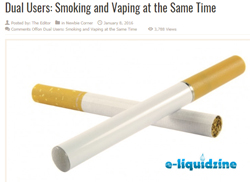 Research findings continue to astonish and even outrage 'Vaping' fans who have long argued that E-Cigarettes are not at all harmful and save lives through stopping or at least cutting down the amount of tobacco cigarettes being smoked. Research findings continue to astonish and even outrage 'Vaping' fans who have long argued that E-Cigarettes are not at all harmful and save lives through stopping or at least cutting down the amount of tobacco cigarettes being smoked.
But there still remains no clear evidence that the use of E-Cigarettes is resulting in an equivalent cut in smokers. In fact there is anecdotal evidence that many smokers are now using both tobacco and e-cigarettes, preferring to use normal cigarettes and having the E-cig handy when they run out.
With this issue of vapour now raising its head again, given the 'fad' for producing as much vapour cloud as possible amongst enthusiastic users of E-Cigarettes, the concern is that the risk to those inhaling these ever increasing emissions; becomes even greater.
A BBC TV programme broadcast in 2016 looked at the chemicals in the liquid nicotine used in E-Cigarettes (propylene glycol and glycerol) which are also given off in the vapour, and concluded that despite them being commonly used in things like face make-up, there is a big difference between them being used on skin as opposed to being inhaled direct into the lungs as happens when using E-Cigarettes.
Such chemicals when inhaled are potentially dangerous it said and neither propylene glycol or glycerol have been certified as being safe to inhale. Indeed, this use of them has never previously been suggested or tested.
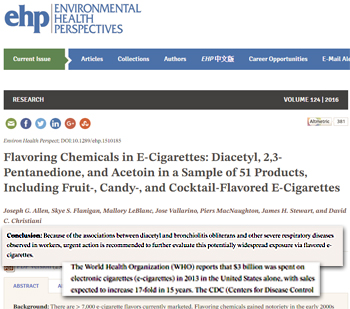 Even further evidence of harmful effects of inhaling flavourings was provided by the School of Public Health in Boston in the USA. Even further evidence of harmful effects of inhaling flavourings was provided by the School of Public Health in Boston in the USA.
Inhalation exposure of the flavouring chemical diacetyl was found to be associated with a disease that became known as “popcorn lung.” and there are over 7,000 E-cigarettes flavourings being marketed without any concern for the impact upon those inhaling the flavourings has on their health.
So-called 'popcorn lung' referred to the pop-corn factory workers who were reported to have severe bronchiolitis obliterans which is an irreversible loss of pulmonary
function that can become so severe that the only treatment option may be a lung trans
plant.
The researches looked at flavouring chemical diacetyl and two other high-priority
flavouring chemicals, 2,3-pentanedione and acetoin, which are present in a convenience sample of flavoured e-cigarettes.
They selected 51 types of flavoured e-cigarettes sold by leading e-cigarette brands and
flavours they deemed were appealing to youth. E-cigarette contents were fully discharged and the air stream was captured and analyzed for total mass of diacetyl, 2,3-pentanedione, and acetoin.
At least one flavouring chemical was detected in 47 of 51 unique flavours tested. Diacetyl was detected above the laboratory limit of detection in 39 of the 51 flavours tested, ranging from below the limit of quantification to 239 μg/e-cigarette. 2,3-Pentanedione and acetoin were detected in 23 and 46 of the 51 flavours tested at concentrations up to 64 and 529 μg/e-cigarette, respectively.
They concluded from this:
"Because of the associations between diacetyl and bronchiolitis obliterans and other
severe respiratory diseases observed in workers, urgent action is recommended to further evaluate this potentially widespread exposure via flavoured e-cigarettes."
More worryingly is the denial of manufacturers of some e-cigarettes who claimed to the researchers that diacetyl is not present ion their products despite the findings by the research. Denial of course was the main method of the tobacco industry when they were questioned about the health issues around tobacco products.
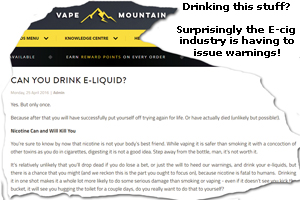 The degree to which e-cigarettes contribute to serious health remains the subject of much debate both in the UK and worldwide. In the US, concerns about the potential health impact of electronic cigarettes has resulted in the U.S. Food and Drug Administration tightening up on its regulation of them last year. (2016) The degree to which e-cigarettes contribute to serious health remains the subject of much debate both in the UK and worldwide. In the US, concerns about the potential health impact of electronic cigarettes has resulted in the U.S. Food and Drug Administration tightening up on its regulation of them last year. (2016)
However, in the UK, no such Government or its health agencies have shown as much concern and such attitudes may well be putting people at risk, and not just users of the product but of those forced to inhale the vapours given off by E-Cigarettes.
The attitude of many promoting E-Cigarettes and of many users seem to mirror that of the Tobacco industry in the 1950s - moral outrage, defence, rejection of studies findings and the making of personal attacks against anyone suggesting that there may be a health problem with the product.
Like with the big tobacco giants of the 1950s doers this same attitude curtails serious debate and research of E-cigarettes and education of the public; as it did back then with conventional cigarettes?
Source: C Ingram / Science Daily / American Chemical Society / BBC / Journal of Analytical Toxicology / Annals.org / Daily Mail / Vape Mountain
See also: Is The E-cigarette The New ‘Tobacco Industry Scandal’ Waiting To Surface After The Health Damage Is Done?
|